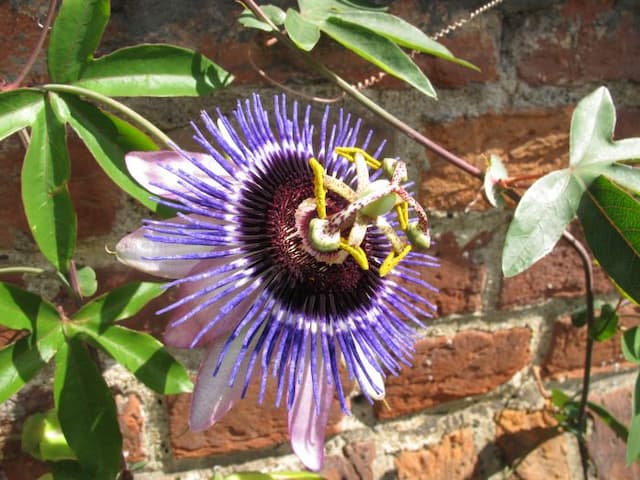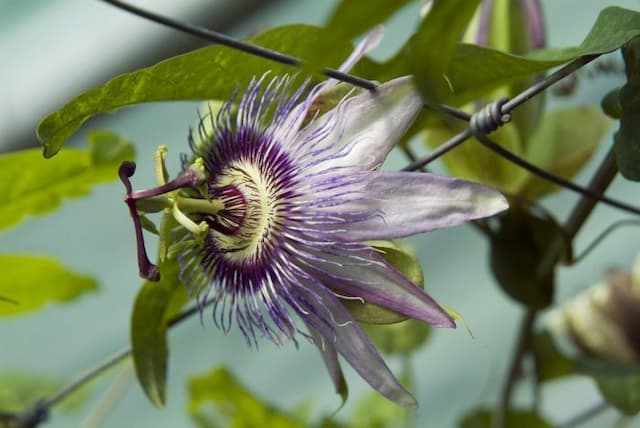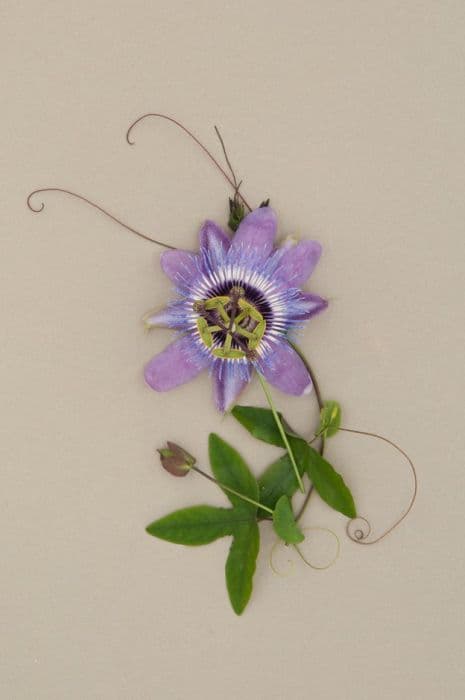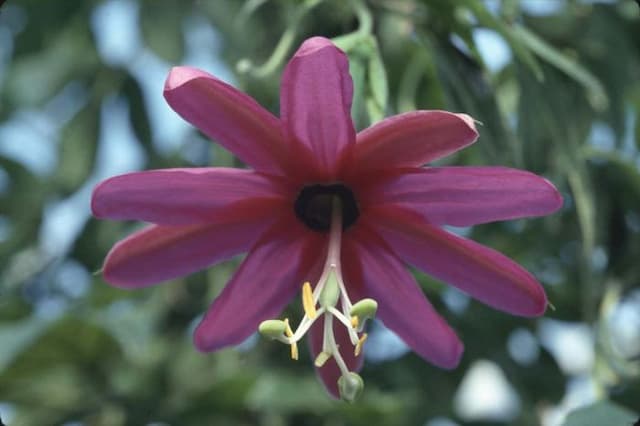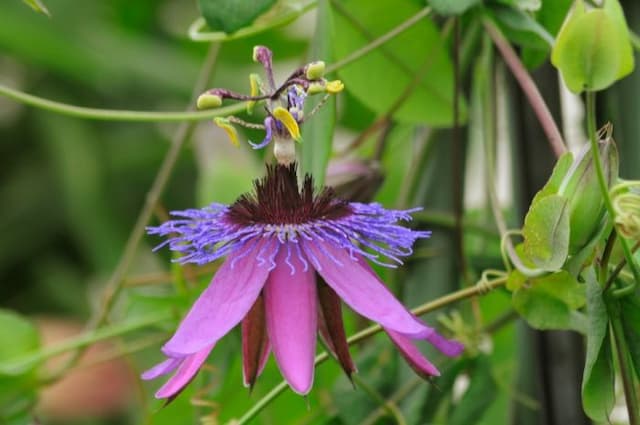Passionflower Passiflora incarnata (F)

ABOUT
Passiflora incarnata, commonly known as maypop, is a fast-growing perennial vine with climbing or trailing stems. This plant is renowned for its large and intricate flowers that have a unique structure. The blossoms are typically around 2 to 3 inches in diameter, showcasing a base color of white or pale lavender with a central structure that resembles a crown. This crown is made up of a fringed corona of thread-like rays, ranging from white to purple with filaments that may be banded with purple or blue. The leaves of the maypop are alternate and palmately three-lobed, measuring 6 inches long and wide, with a serrated margin giving them a delicate lace-like appearance while being robust at the core. Tendrils are present for climbing, and these spiral around any support they can find, allowing the maypop to ascend and spread. The fruit of the maypop is an oval yellowish berry that is edible when ripe. It contains numerous small seeds surrounded by a gelatinous pulp that offers a mildly sweet flavor. While the plant does not detail size in terms of height or spread, it is commonly known to have a vigorous growth habit and can cover a considerable area if left unchecked.
About this plant
 Names
NamesFamily
Passifloraceae.
Synonyms
Maypop, Purple Passionflower, True Passionflower, Wild Apricot, Wild Passion Vine.
Common names
Passiflora incarnata var. hirsuta, Passiflora hirsuta, Passiflora macrophylla, Passiflora incarnata var. pubescens.
 Toxicity
ToxicityTo humans
Passionflower, specifically Passiflora incarnata, is generally considered safe for human consumption when used appropriately. The parts of the plant, including the fruit, leaves, and flowers, are often used in herbal preparations for their sedative and anxiety-reducing effects. There are no major toxic effects known for humans when consumed in normal food quantities or as a herbal supplement. However, excessive consumption could potentially lead to side effects such as dizziness, confusion, irregular muscle action and coordination, altered consciousness, and inflamed blood vessels. Pregnant women should avoid consuming large amounts as it may stimulate uterine contractions. As with any herbal supplement, it is essential to consult with a healthcare provider before use.
To pets
Passionflower, or Passiflora incarnata, is not commonly listed as toxic to pets such as dogs and cats. However, as pets may have different sensitivities than humans, and given the sedative nature of some compounds present in the plant, it is possible that pets could experience mild gastrointestinal symptoms if they consume large amounts of the plant. Symptoms might include vomiting or diarrhea. In general, it is best to prevent pets from ingesting plants not specifically intended for them, and if a pet does consume passionflower and shows signs of distress, a veterinarian should be consulted.
 Characteristics
CharacteristicsLife cycle
Perennials
Foliage type
Deciduous
Color of leaves
Green
Flower color
Purple
Height
6 feet (1.8 meters)
Spread
3 feet (0.9 meters)
Plant type
Climber
Hardiness zones
6
Native area
Southeastern United States
Benefits
 General Benefits
General Benefits- Attracts Pollinators: Passiflora incarnata, commonly known as maypop, attracts bees, butterflies, and other pollinators to the garden, contributing to the health of the local ecosystem.
- Edible Fruits: The maypop produces edible fruits that can be consumed fresh or used in various recipes, such as jams and desserts.
- Ornamental Value: With its intricate, exotic-looking flowers, the maypop is popular for its ornamental value, adding aesthetic appeal to gardens and landscapes.
- Ease of Care: Maypop is a hardy plant that can thrive with minimal care, making it suitable for gardeners of all levels of experience.
- Fast Growth: This fast-growing vine can quickly cover fences, arbors, and trellises, providing privacy and shade.
- Natural Dye: The plant can be used to produce a natural dye for fabrics.
- Drought Tolerance: Once established, the maypop is drought-tolerant, making it ideal for xeriscaping and low-water gardens.
- Soil Enrichment: As a member of the Passifloraceae family, it can enrich the soil by adding organic matter through its decomposing leaves.
 Medical Properties
Medical Properties- Anxiolytic: Often used for its calming and anxiety-reducing effects.
- Sedative: Commonly employed to promote relaxation and improve sleep quality.
- Antispasmodic: May help relieve muscle spasms and tension.
- Analgesic: Contains components that are thought to have mild pain-relieving abilities.
- Nervine: Used traditionally to support the nervous system.
 Air-purifying Qualities
Air-purifying QualitiesThis plant is not specifically known for air purifying qualities.
 Other Uses
Other Uses- Passiflora incarnata, commonly known as maypop, can be used as a natural dye due to the pigments present in its flowers and fruit.
- The delicate vines of maypop can be woven into small handicrafts or jewelry, making sustainable decorative pieces.
- The fruit of the maypop can be utilized in making jelly and jam, offering a unique, tropical flavor to complement bread and pastries.
- Its attractive flowers make maypop an ornamental plant for gardens or as part of floral arrangements for an aesthetic appeal.
- The hollowed-out fruit of maypop can serve as a natural, biodegradable container for small items or seeds.
- Maypop vines can be used in erosion control due to their robust root system which helps stabilize the soil.
- Dried maypop leaves can be incorporated into potpourri mixes to add fragrance and texture.
- The leaves of the maypop can be used as food for certain types of livestock, such as rabbits and goats.
- As a climbing plant, maypop can be used to create living fences or privacy screens in gardens and patios.
- Maypop’s rapid growth and dense coverage make it suitable for use in a children's garden, providing a quick-growing play area or natural "hideout".
Interesting Facts
 Feng Shui
Feng ShuiThe Passionflower is not used in Feng Shui practice.
 Zodiac Sign Compitability
Zodiac Sign CompitabilityThe Passionflower is not used in astrology practice.
 Plant Symbolism
Plant Symbolism- Passion: Passiflora incarnata, commonly known as Maypop, is a symbol of passion and attraction, reflecting its namesake, the "Passion" in Passion Flower, which is derived from the Passion of Christ and the plant's complex structure.
- Christian Faith: This plant is imbued with Christian symbolism; its various parts are thought to represent significant aspects of the Passion of Christ, such as the crown of thorns, the wounds of Christ, or the apostles.
- Suffering and Sacrifice: The intricate patterning of the Passion Flower can also symbolize the intricacies of suffering and sacrifice, as it is historically connected with the suffering (Passion) of Christ.
- Peace and Serenity: Maypop is often associated with bringing peace and calmness, which is why it's used in gardens and homes as a reminder to relax and provides a serene and tranquil atmosphere.
- Spiritual Enlightenment: Due to its unique and complex structure, the flower is also seen as a symbol of spiritual enlightenment, thought to represent the search for meaning in life.
 Water
WaterMaypops, the common name for Passiflora incarnata, prefer consistent moisture but do not thrive in waterlogged conditions. During the growing season, water deeply once a week with about 2 gallons per plant, ensuring you are soaking the root zone. In periods of drought or extreme heat, increase watering frequency to twice a week. Reduce watering in the winter when the plant is dormant. Always check the soil before watering; it should be moist but not soggy.
 Light
LightMaypops thrive in full sun to partial shade. For optimal growth, plant them in a location where they can receive a minimum of 6 hours of direct sunlight per day. A spot with morning sun and afternoon shade is ideal to protect the plant from the intense heat of late day sun.
 Temperature
TemperatureMaypops can survive in a broad range of temperatures, but their ideal range is between 70°F and 85°F. They are hardy in USDA zones 5 to 9 and can survive minimum winter temperatures of as low as -20°F. Extreme temperatures above 100°F may stress the plant.
 Pruning
PruningMaypops should be pruned to maintain shape, remove dead or damaged growth, and encourage bushier plants. The best time to prune is in early spring before new growth begins. Prune as needed throughout the growing season to keep the vine manageable and cut back by about a third annually.
 Cleaning
CleaningAs needed
 Soil
SoilMaypop, commonly known as Passionflower, thrives in well-draining soil with a pH of 6.0 to 7.5. A mix of loamy soil, peat, and perlite or sand is ideal to ensure adequate drainage and aeration. Adding compost can provide nutrients and enhance soil structure.
 Repotting
RepottingMaypop should be repotted every 2-3 years or when it becomes root-bound. Spring is the best time for repotting, giving the Passionflower a chance to establish in the fresh soil before the growing season.
 Humidity & Misting
Humidity & MistingMaypop prefers moderate to high humidity levels, around 50-60%. If grown indoors, a humidifier or regular misting can help maintain these humidity conditions for optimal growth.
 Suitable locations
Suitable locationsIndoor
Place Maypop in bright, indirect light and maintain humidity for indoor growth.
Outdoor
Plant Maypop in full sun to partial shade in well-draining soil.
Hardiness zone
6-9 USDA
 Life cycle
Life cyclePassiflora incarnata, commonly known as purple passionflower or maypop, starts its life as a seed, which upon encountering favorable conditions of warmth and moisture, germinates to produce a small seedling. This seedling grows into a vine that vigorously climbs using tendrils, with leaves unfurling to start the process of photosynthesis. After establishing a strong root system and vegetative growth, the plant reaches maturity and begins to flower, typically in early summer. The intricate, unique flowers are pollinated by insects, leading to the development of ovary into a fleshy fruit called a maypop. Fruits mature, containing many seeds that are then dispersed by animals or gravity, completing the reproductive cycle. The plant may die back in winter in colder climates but can re-emerge from its root system in the following spring.
 Propogation
PropogationPropogation time
Spring-Summer
The most popular method for propagating Passiflora incarnata, commonly known as Maypop, Purple passionflower, or Wild passion vine, is via seed. Seeds should be collected after the fruit has ripened and the pulp has begun to dry. Clean the seeds by removing them from the pulp and allowing them to dry. Prior to planting, a stratification process is beneficial, which involves mixing the seeds with slightly moistened sand and storing them in a refrigerator for three to four weeks. After stratification, seeds can be sown directly in a well-draining soil mix, covering them with a thin layer of soil, approximately 1/4 inch (about 6 millimeters) deep. Seeds generally germinate best when the temperatures are between 68 to 86 degrees Fahrenheit (20 to 30 degrees Celsius). Once established, seedlings can be transplanted into the garden after the risk of frost has passed.





